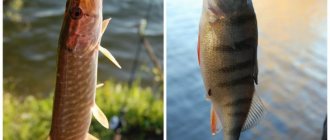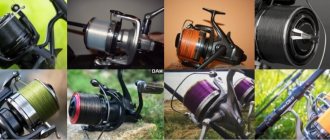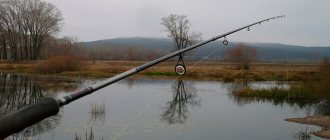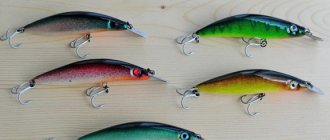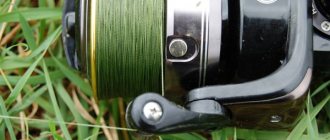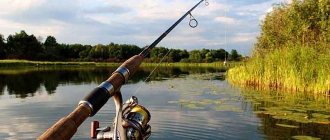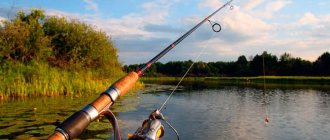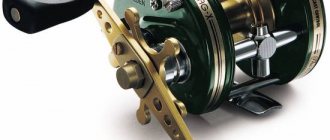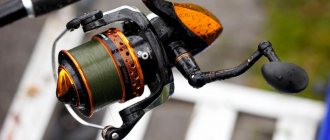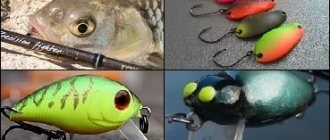Story
Spinning
, whose homeland is England, quickly spread among fishermen. In this country, spinning fishing first began in the second half of the 19th century. At first, the British cast bait without a reel. The fisherman pulled the line from the reel with his hands and then laid it in rings on the ground at his feet. After this, the rod was cast in such a way that the line rose from the ground and was carried away by the bait, going through the rings. In the 19th century in Russia they cast bait in the same way.
The first information about spinning in Russia appeared in Sabaneev’s journal “Nature and Hunting” for 1880. The article was written by P. G. Cherkasov. In it he gave a description of casting using the above method. Thus, at first, the reel on the rod served only to store a supply of line and help in landing the caught fish.
Today, spinning fishing is the most popular and in demand technique all over the world.
Is there a universal spinning rod?
What if you need a universal spinning rod of medium power
(5-25g.), for example, for fishing with popular techniques: jig and twitching.
Is it possible to choose a universal option here? In this case, spinning can be called universal only under certain conditions
:
Condition 1.
If baits of approximately the same weight (10-18g) are used.
Condition 2.
If the universal rod length is used, which is about 7.6 feet or 2.29 meters.
Condition 3.
The spinning rod must be of high quality. Made from high modulus carbon fiber and assembled in Japan. Such spinning rods have a complex structure that can suit different conditions. The spinning material will provide a high level of sensitivity and control over the bait (in jigging and twitching).
Only under specific conditions:
Short twitching spinning rods (up to 2.1 m) or long jigging rods (2.7-3 m) will work perfectly only for the purposes for which it is made. They will be less suitable for some other tasks, and not suitable for others at all. They cannot be called universal in any way.
We've sorted out the nuances of versatility. Now let's talk about choosing a spinning rod.
- for medium-sized fish, blanks 2.1 m in length are best suited;
- for large specimens weighing more than 3 kg, you can take gear within 2.7-3.1 m;
- when fishing in cramped conditions or from a boat, a length of 1.6-1.8 m is sufficient to catch small fish weighing up to 2 kg.
Spinning device
Spinning rod Spinning
consists of the rod itself with guide rings, a reel, usually without inertia, fishing line or braided cord and, accordingly, the bait itself, a spinner or silicone fish.
The design of the spinning rod
in more detail below.
Rod
A spinning rod is designed for casting a fishing line with heavy bait. When throwing such baits over a considerable distance, the rod experiences great stress, so it must be elastic and durable and at the same time flexible. A rod that is too rough and powerful will tear thin fishing line when hooking and retrieving fish.
Modern spinning rods are usually made of carbon fiber, fiberglass, and metal.
Spinning rods differ in the following characteristics:
- length
- test
- Class
- build
Spinning rod length
indicated either in meters (European manufacturers) or in feet and inches (American manufacturers). For ease of transportation, spinning rods are usually made with two legs or even multi-legs - the so-called. travel concept. There are also single-legged rods (extremely rare, and used for special tasks - for example, for casting competitions). Telescopic spinning rods are also produced.
Rod test
is the recommended weight of baits to be thrown. It is indicated either in grams or in ounces (libres). Two values are indicated - the minimum weight that can be cast by a given rod, and the maximum weight that can cast the bait without overloading the rod.
The rod test directly affects the class of the rod
.
By class, spinning rods are divided into 4 main types (not counting intermediate ones): ultra light class, light class, medium class, heavy class. Table of correspondence between the power of the spinning rod and the maximum weight of the bait being thrown. The division into classes is arbitrary and may differ among different manufacturers, but one of the popular and generally accepted ones looks like this:
- ultra light class (Ultra Light) - test up to 7 g;
- light class (Light) - test from 7 to 15 g;
- middle class (Moderate) - test from 15 to 40 g;
- heavy class (Heavy) - test from 40 g and above.
Another important characteristic of spinning rods is the action of the rod.
, which refers to the Young’s modulus of elasticity coefficient inherent in a particular fishing rod. This is how spinning rods of fast, medium and slow action are distinguished. There are two interpretations of the system, we will express both. According to the first interpretation, it is understood that with a fast action, only the very tip of the spinning rod bends, and with a slow action, the entire form of the spinning rod bends under the maximum declared load. Also in the literature, the concept of spinning rod action is often used, as the time the rod returns to its original state after casting. The sensitivity of the spinning rod depends on the action. On the one hand, the stiffer the rod, the better it transfers all the vibrations of the bait into the fisherman’s hand; on the other hand, the stiffer the rod, the shorter the casting range of the bait. As the rigidity of the rod increases, its bite is lost.
In addition to length, test, class and action, some manufacturers may indicate a recommended fishing method (for example, jig head, twitching, etc.).
Coil
There are three main types of spinning reels - inertial, inertial-free and multiplier. Let's look at each of these types separately and find out how they differ from each other.
Inertia coil
Inertia coil
Inertial coil Inertia-free coil Multiplier coil Inertial coils
are the simplest and cheapest type. The main distinguishing feature is the absence of a line braking mechanism during casting. In this regard, a person has to use his finger to stop the process of unwinding the coil. There are inertial reels that are equipped with a braking mechanism in the form of a screw and a lock nut.
If, after all, the choice fell on an inertial reel, then attention should be paid to the material used to make the equipment, the balanced rotation of the drum and its ease of movement.
Spinning reel
Spinning reels
equipped with a fixed drum or spool. When casting the bait, the line is pulled off the spool due to the gravity of the load. A spinning rod equipped with this equipment must have a spare spool and a balsa wood insert.
These coils are much more convenient to use than the previous type. There is no need to use the braking mechanism when casting. The reel can be used for fairly long casts and with very light baits. In this case, the spool must be completely filled with fishing line.
The spinning reels are equipped with an adjustable friction device. The presence of this device saves the fishing line from breaking during strong jerks when catching large fish.
In addition, the reels are equipped with a “stopper” mechanism that prevents reverse rotation. In this regard, a distinction is made between high-speed and traction reels. They differ from each other in the number of bearings and the rotation handle. In addition, spinning reels differ in the type of drive mechanism. There are bevel gear, bevel hypoid and screw drive reels. These reels differ in the shape of the gears. The first type has gears with straight teeth, the second type has helical teeth, and the third type is equipped with a gear-worm mechanism. Screw-driven reels are considered the most reliable and high-quality.
Inertialess reels are easy to use due to the ability to attach the handle on any side and adjust it to the person.
Multiplier reel
Multiplier reels
the most expensive type. He combined the inertia-free and inertial appearance. A spinning rod equipped with this type of reel has ease of casting and high control over the tackle. The reels have a centrifugal type braking mechanism. The braking force depends on the weight of the load, which plays the role of the braking mechanism. But, despite this, a person must monitor the braking force and sometimes independently slow down the rotation of the drum with his finger. It should be noted that if the fishing line gets tangled, it will be quite difficult to untangle it compared to other types of reels.
This type of reel can be used for any type of fishing. The only exception is fishing with small loads. This requires manual dexterity and a little practice.
Multiplier reels are difficult to operate and expensive, but reliable and durable compared to other types.
Passing rings
Guides Guides and the tulip
(the ring on the tip of the rod) are made from the hardest materials. So, if these are homemade rings, amateur fishermen even use bearing races as liners. The best material for guide rings is SIG - silicon carbide. A recognized leader in the production of rings - (the manufacturer engraves its name on the stem of the ring). The most important characteristic of the components of this gear is its lightness. The lightest rings are those coated with titanium nitride. They also differ in their smaller sizes.
The rings perform one important function - they evenly distribute the load from the fishing line along the rod blank. Both the casting distance and the landing of fish partly depend on the rings. When choosing a spinning rod, it is important to check whether the rings are attached to the rod well, whether the thread is wound evenly, and whether there are any extra protruding drops of varnish. And most importantly, check that there are no cracks, nicks or similar surprises on the rings. Any crack, even a small one, can cut your fishing line or braid in a matter of seconds.
fishing line
Fishing line for spinning fishing can have different thickness, color, and breaking capacity. But most importantly, the fishing line can be one of three types of cords:
- Monofilament fishing line (monofilament);
- Wicker;
- Fluorocarbon.
All three types have different strength, stretchability, and refractive index.
A spinning line must have two contradictory properties: it must be thin and strong. The need for strength is obvious to everyone. But how important it is that the fishing line be as thin as possible is underestimated by many. If, when fishing with a float or jig, you use a thinner line instead of a thick one, the number of bites immediately increases, and this is obvious to anglers. This does not happen in a spinning rod - the fish does not have time to look at the fishing line before casting, much less feel it after grabbing it. But the thickness of the fishing line greatly affects the casting distance, especially if you are fishing with a spinning reel. Reducing the diameter by just 0.01mm increases casting by about 5%. That is, by replacing, for example, a 0.3 mm fishing line with a 0.2 mm one, you will cast an average-weight spinner one and a half times further.
Leash
Leashes The leash must be:
- strong;
- as subtle as possible;
- hardly noticeable in water;
- moderately elastic;
- should not be collected in a spiral.
The length of the leash depends on the length of the rod, the type of bait, the method of maneuvering it, the experience of the angler and his taste. The normal leash length for a two-handed rod is approximately 70 cm. It can be increased or decreased; some spinning anglers use leashes 20-30 cm long.
For a one-handed rod, the optimal length is considered to be at least 45 cm, but not more than 70 cm, since the long leash length with such a rod makes casting uncomfortable.
Spinning lures
Spinner
(spinner, spinner) - a metal spoon, has an axis on which the petal is located, when inserted in the water it begins to spin adjacent to the axis and creates high-frequency vibrations. Reminds me of a shiny fish.
Oscillating spoon
(oscillator) - a metal spoon of a curved shape, with a hole for inserting a fishing line on one side and a hook (tee or double) on the other side.
When wiring, it creates low-frequency vibrations and is very similar to the behavior of a real fish. Spinning baits Twisters
(rubber bait) - have the shape of a worm of varying thickness, usually not very long, and the tail is very thin and has a curved shape. Due to its structure, the tail begins to vibrate during the retrieve, and the bait looks like a fish, not a worm.
Vibrotails
(rubber bait) - also made of silicone, looks like a fish, and the tail is made in the shape of a paddle, which, when the bait is held in the water, vibrates and the tail begins to move from side to side, like the tail of a real fry.
Wobblers
- plastic fish of various sizes, shapes and colors. They differ in the presence/absence of a blade in the area of the fish’s mouth, which allows it to go deeper and gives play to the wobbler. The depth of the wobbler depends on the angle of the blade to the fishing line. There are both surface and deep-sea wobblers, and they also differ in the degree of buoyancy: floating, suspended (zero buoyancy), sinking in the water.
Castmaster
- a special case of an oscillating spoon. It has high aerodynamic characteristics, allowing for very long-distance requests. This is a surface spinner, even despite its high weight. Excellent for such wary fish species as asp, ide, chub.
Artificial front sight
- hook with feathers. It is used in spinning fishing in combination with a sinker, and the fly itself or a number of them are attached to small leashes. Flies are also widely used in Sbirulino rigs with a heavy float.
Devonian
- a spinner, which is an oblong metal part with blades, which, when inserted, begins to spin around its axis, creating vibrations that attract predators.
Spinnerbait
– is a “yoke” made of bent wire, with a petal attached to one end and a fly or silicone squid to the other. Such a bait does not resemble any living creature, but it is generally accepted that it arouses interest due to the large number of stimuli (high- and low-frequency vibrations, bright colors).
Spinning form
The main part of the rod is the whip itself, which in fishing terminology is called a blank.
We have already talked about the material of the blanks, we just need to add that expensive “sticks” use multi-layer (not only longitudinal, but also transverse) weaving of fibers, which makes it possible to achieve the highest quality, because the outer surface of the blank bends more than the inner one, and the top of the rod - more than the butt.
In addition to the composition of the fabric and binder, the strength of the blank is also determined by the thickness of the walls. However, excessively thick walls significantly make the entire rod heavier, so designers must find a reasonable compromise between the strength and weight of their “brainchild.” But, due to the desire to make a blank of minimal weight, this is not always possible - so I recommend being careful with rods that are too thin-walled.
To strengthen thin-walled forms, they are additionally (along the entire length or partially) wrapped in a spiral crosswise with Kevlar threads. Then the workpiece is varnished. A layer of varnish not only gives the rod a more elegant look, but most importantly, it protects the blank from scratches and reduces the risk of annoying breakage.
When choosing a fishing rod, also evaluate the taper of the blank. The diameters of the tips of modern “sticks” are approximately the same, but the thickened butt immediately reveals a model with a greater taper. Such a spinning rod, all other things being equal, turns out to be more powerful and “fast”.
But special attention should be paid to the joint of the rod (Fig. 3), because according to statistics, after a broken tip, the next likely place of failure is near the joint.
Fig.3. Rod joint: a) internal, b) external, c) end (pin). Arrows: fungus, winding, bandage, tube.
First of all, the joint must be long enough. It is believed that if the inner knee enters the outer one by 5-6 of its diameters, this is the norm. If it’s a little more, it’s also okay. The main thing is that the entire connection is tight.
To strengthen the joint and prevent it from loosening, a rubber mushroom is glued into the end of the inner elbow, which also protects the cavity from dirt. The “fungus” cap to some extent compensates (or hides?) the leakage of the joint. Therefore, a tight connection without a “fungus” is even more reliable, but the end hole should still be closed with a light plug.
For the same reasons, a reinforcing winding is always made on the outer knee, and sometimes a metal bandage ring is even put on.
However, any joint will still become loose over time, but it can and should be adjusted again. For “sticks” with an external joint, this is quite easy to do by slightly shortening the inner part (so that it does not “crawl out” beyond the reinforcement boundary) and grinding its surface along the diameter in the right place. For an internal joint, such an operation is unacceptable, because the upper knee can simply fall into the lower one. Here you have to first “increase” the inserted part in diameter with durable varnish, and then sand off the excess.
At the initial stage, the “old-fashioned” stearic method is also applicable. Stearin not only seals the old joint, but also makes it easier to separate.
Structurally, the most durable joint is the end joint (or pin joint) through a graphite rod glued into the lower elbow. An additional advantage is that such a connection has less impact on the uniformity of the rod’s action, because the joined halves have almost the same diameter. The correct end joint does not settle completely, but has a small margin along the upper elbow, which is gradually “worked out” during operation.
A jammed joint can cause quite a lot of trouble. If this happens and the usual measures do not help, there are several ways:
Spinning rod care
Since the spinning rod consists of several parts, each part must be looked after separately and carefully.
Rod
after fishing, you need to carefully inspect for possible damage (if possible, deal with the damage yourself, if not, trust the professionals), clean from dirt, sand, fish mucus and other contaminants using water and any detergent (after covering the joints), Wipe dry with a soft cloth, dry the fishing line and handle.
Particular attention should be paid to the connections: if even a tiny grain of sand gets into the holes of the connections, the spinning rod will be severely damaged, so it is recommended to insert plugs made of rubber, rags or wood into the holes. A telescopic rod requires more careful care: the contact points between the segments must be treated with special silicone or wax to prevent jamming later. Cover for spinning rod After all the manipulations done, the rod must be hidden in a cover or tube.
If the spinning rod was sold packaged, this is very good, but if not, no problem: stores sell special cases that you can use. Many fishermen themselves make “packaging” suitable for their spinning rods, but it must be taken into account that fabric covers cannot protect the rod from damage as well as tubes. If it is still not possible to purchase a real cover, then it is better to make one made of fabric and sew it yourself than none at all, just keep in mind that just a narrow sleeve will not work for this. An open cover made of rubberized fabric with pockets located along the edges and with laces sewn to one side is recommended. This case will fit not only a fishing rod, but also a stand for it, etc. Remember that caring for a spinning rod should not begin immediately after fishing; a fishing rod (especially a graphite one) requires constant attention and careful treatment always and everywhere: during transportation, during during fishing, during breaks, etc. Try to protect the rod from accidental impacts, damage (even small ones), under no circumstances transport several rods in one case without separation, do not swing the rod with force, do not place it on the ground or stones, and also - most importantly - on dry fine sand.
Spinning reel
- a very important part of spinning and requires a very serious attitude. The main care of the reel is its cleaning and lubrication, especially at the beginning, middle and end of the season, when the reel gets into water, as well as when it moves with difficulty and suspicious sounds. However, if you are not yet proficient in this art, it is better to entrust the disassembly and cleaning of the coil to specialists. All you can do on your own is lubricate the line roller, the bearings on the handle axis, clean the brake and wipe open areas with alcohol. Remember that when lubrication, use only special coil lubricant, without replacing it with anything else.
If you follow basic requirements when fishing, the reel will serve you faithfully for a long time. The most important rule: do not allow the reel to come into contact with water and sand. It is equally important to always have a special reel lubricant with you (lubricant that thickens in cold weather and water that accidentally gets into the reel from a wet line can be easily corrected with a drop of fresh lubricant).
Don’t forget about fishing line, rings, spinners
etc.: at the end of the season, unwind the line from the reel on a reel, wipe it with glycerin, wrap it in something and store it in a dark, cool place; Clean the spoon and rings from dirt and lubricate with machine oil.
Choosing a spinning reel
Today, the following types of coils can be noted:
- Inertialess.
- Multiplier (inertial).
Multiplier reels are also called “sea” and they are designed for catching large, trophy fish. They are somewhat more difficult to use, but in classical conditions they are no better than inertia-free ones, the simplicity of which is one of the main advantages. In this regard, most spinners prefer inertia-free designs. The coil consists of:
- from a spool;
- spool movement mechanism;
- friction brake;
- rotor;
- rotor rotation mechanism;
- rotor reverse rotation stopper;
- handles;
- housings;
- line layer.
How the reel is attached to the spinning rod
Each rod has a place for attaching a reel. To secure it, you need to:
- Loosen the bottom nut so that the reel handle fits into the reel seat.
- Tighten the nut tightly, but very carefully, otherwise you may strip the thread.
Reel spool
In essence, it is a drum on which the fishing line is wound. High quality spools are made of metal, and their front part is coated with titanium nitride for greater wear resistance. The spool must indicate how many meters and what thickness of fishing line the spool holds.
Friction brake
This is a structural element designed to protect the coil from excessive loads. Before going fishing, it is advisable to adjust the friction brake:
- The end of the fishing line should be secured to a solid base, after which you need to move away a few meters.
- Having tightened the clutch completely, they begin to tighten the fishing line. At the same time, you need to take into account the strength of the fishing line so as not to break it.
- After this, slowly release the clutch until the reel begins to release the line.
There is another, more accurate way to adjust the clutch, when a load of pre-known weight is attached to the tackle. For example, bricks are often used, the weight of which reaches 5 kg. This approach allows you to more accurately adjust the clutch.
Number of reel bearings
For spinning, this is a very important point, which indicates how high quality the reel can be. Their number can range from 0 to 12 pieces. Despite this, 5-6 bearings are enough if you have to fish in classic conditions. For example:
- 1 or 2 bearings must be on the rotor gear.
- 2 bearings should be located on the axis of the handle.
- 1 bearing must be present in the line laying mechanism.
Naturally, the more bearings, the more reliable the reel can be. It is very important that the reel mechanism ensures quiet operation and smooth operation.
Spinning fishing
Where to begin? First you need to determine what kind of fish you will collect gear for and the conditions for future fishing. After purchasing the gear and necessary accessories, you need to assemble the spinning rod. It's not difficult at all:
- A reel with fishing line is installed on the spinning rod. It should be located at a distance of 30 to 40 centimeters, counting from the first ring;
- Depending on the fishing conditions and whether long casting is required, choose the length of the fishing line. As a rule, 40–70 meters is quite enough for spinning fishing;
- Attach a leash to the end of the fishing line. Fishing can be done using a leash made of fishing line or tungsten, a durable metal. If you are fishing for fish that swallow bait deeply or that have very sharp teeth or graters, like catfish, then you need to choose a long leash. Moreover, it must be metal;
- Secure the fish bait with a special carabiner.
When the gear is collected, it's time to start fishing. If you are going to use a spinning rod often, then you need to learn how to throw the tackle over your shoulder, from the right, from the left, or from under your hand. Moreover, you definitely need to study all the casting methods, since fishing can be done in a variety of conditions: in one place it will be advisable to throw the tackle from under your hand, and in another there is room for casting over your shoulder. We will look at casting methods in more detail below.
After casting, the angler waits for the bait to sink to the bottom. Moreover, when falling, the bait should not touch the water with a splash: this will scare away all the fish. After it has reached the bottom, you need to lift it to the working depth and start wiring. Fishing is more effective at a distance of 40 to 50 centimeters from the bottom, since the bait that moves along the bottom is less noticeable.
Spinning rings
Guides are the second most important component of a spinning rod. The rings are counted from the handle to the end of the whip, and the latter is called a “tulip”.
Structurally, the ring consists of a durable insert fixed in a special frame (frame). The frame, in turn, has 1-2 legs with paws for attaching to the fishing rod. The strongest and lightest frames are made from titanium.
Nowadays, rings on one foot are used very widely, since, firstly, they are lighter, and secondly, they practically do not change the original structure of the form. Well, we learned how to attach them to a fishing rod almost as reliably as rings on two legs. And only on fairly powerful spinning rods, either the first one or two, or all the rings are still made in the “old” reinforced version.
But the main working element of the ring is a solid insert. Products with metal and porcelain inserts have sunk into oblivion. Currently, high-quality rings are made from only three materials: aluminum oxide (Al2O3), silicon carbide (SiC) or a light metal surface coated with a high-strength alloy (for example, titanium nitride).

